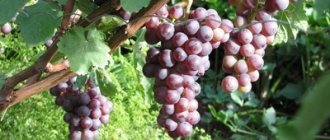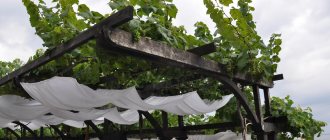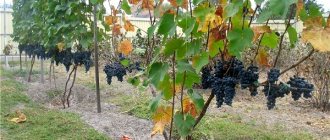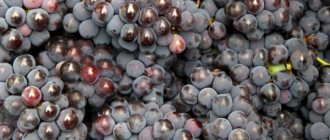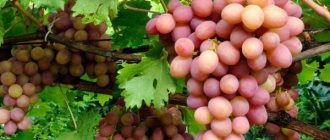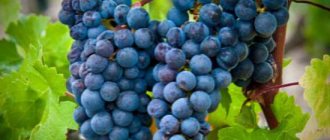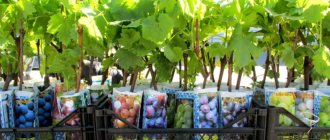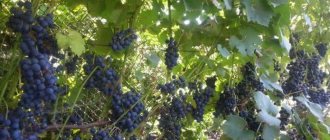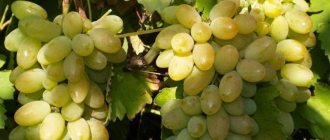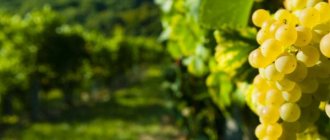Advantages and disadvantages
The Bianca grape variety has some features that every gardener who decides to grow it should know about.
The main advantages of "Bianka":
- Early maturation.
- Consistently high yield.
- Fast growth.
- Frost resistance.
- Lack of tendency for berries to fall and pea.
- Resistance to powdery mildew.
- High sugar and alcohol content, moderate acidity.
- Beautiful appearance of the bunches.
Also, these grapes are able to independently recover and resume fruiting after illness or freezing.
The variety does not have too many disadvantages. These include:
- Poor transport tolerance.
- Susceptibility to attacks by wasps and birds.
- Low resistance to Alternaria fungi.
- Requirements for lighting and humidity levels.
- Difficulty in manual harvesting due to the small size of the bunches.
In addition, the berries have a short shelf life and need immediate processing.
Wasps are the main pests!
Bianca grapes do often suffer from wasp attacks. But this problem can be solved. You can make covers for brushes from gauze. Thanks to this, Bianca grapes will not be accessible to insects.
Mesh bags and bait placed nearby can also help.
In addition, you can fight wasps with the help of spices planted under the vines. The smell of spices can repel insects. Due to this, the grape berries are protected.
Sometimes the threat comes from birds. Mesh bags made of thin wire, placed on the bunches, will help rescue them. In this case, the gardener will not harm the birds themselves, since they will not get stuck in the soft wire, but the harvest will be saved.
Main characteristics
“Bianca” is one of the best wine grape varieties that can be grown both in private farmsteads and on an industrial scale. The best also include wine varieties such as Merlot, Marquette and Saperavi.
Maturation period and class
This is an early ripening grape variety. The harvest can be harvested 110-120 days after the start of the growing season , i.e. in late July-early August when grown in the southern regions and in the second half of August in the central zone.
Bush
The bushes are characterized by medium growth vigor; tall specimens are extremely rare and are subject to shortening. The vine is dense, well developed, and can withstand a bountiful harvest.
The leaf blades are medium-sized, five-lobed, round in shape, glossy, dark green.
Bunches and berries
At the end of July-August, medium-dense clusters of cylindrical or cylindrical-conical shape are formed on the bushes. The brushes look attractive despite their small size and average weight of 150-200 g. With careful care of the bushes, you can increase the weight of the bunches to 500 g, but this happens rarely and requires significant costs and effort.
The berries are small, have a round shape, weigh on average 1.5-2.5 g and are covered with a thin but durable yellow-green skin, which, as the fruit ripens, acquires a warmer amber hue.
The pulp is fleshy and juicy, contains a lot of water, and contains 1-3 small seeds inside.
The sugar content of the fruit is 28%, the alcohol content is 14%, and the acidity level is 7%.
Reference! If the harvest is harvested 2-3 weeks later than its ripening, the acidity of the berries drops to 3-5%.
Taste
The fruits have a rich, harmonious, characteristic grape taste and almond flavor. According to tasters, the taste may have a slight honey or floral aftertaste.
Productivity
The variety has a fruiting rate of 90-100%. With proper care and favorable weather conditions, up to 20 kg of berries can be harvested from 1 bush, the yield from 1 hectare of land reaches 200 centners.
Bianca grapes: characteristics and description of the variety, planting and care
The Hungarian grape variety Bianka is honored by gardeners in the southern regions of Russia and the CIS countries. The technical grape variety is valued for its excellent taste and stable yield. High-grade wines and strong drinks (cognac, grappa) are obtained from the berries.
Unpretentious grapes bear fruit successfully in most Russian regions. As reviews and descriptions show, he requires standard care without any special difficulties. Beginning summer residents will grow the Bianku variety on their plot without any problems.
Description of the variety
The grapes were obtained by Hungarian breeders, the parent pair being Chasselas Bouvier and the famous sweet Villars Blanc. Bushes of medium vigor, with dense shoots. Maturation – 90-100%.
It is distinguished by the rapid rooting of cuttings and the active growth of young vines. Leaves with five distinct lobes, dark green in color. The appearance of the bushes is very decorative, so Bianka is used to decorate areas.
The harvest is ready for harvest in 120 days (early type of crop). In the southern regions, berries are harvested in early August. After planting, the first clusters appear in the third year. There are 2-3 inflorescences on the shoot.
The variety is frost-resistant, can withstand temperatures down to -27ºC. This allows Bianca to be grown in regions with short summers and harsh climatic conditions. But mainly technical species are cultivated in the south. Thanks to good growth, the vine quickly recovers after freezing.
Usage:
- preparation of table and dessert wines;
- production of vodka;
- production of cognacs of various ages and strengths.
Wine experts note the pleasant taste of wine drinks made from Bianchi berries.
Grapes of this type are resistant to pests; a resistance gene is embedded at the genetic level. This makes it possible to treat the vineyards with chemicals to a minimum and obtain an environmentally friendly product.
Fruit characteristics
By August, small, conical-looking clusters form on the bushes. With proper care they grow to 170-200 grams. The grapes are round, weighing 2-2.5 grams. The color is greenish; as it ripens, the skin acquires warm amber shades.
The pulp contains a large amount of water, the sugar level is 28%. There are usually 2-3 seeds inside. The skin is thin but durable.
Acidity levels are above average - 7%, so experienced winegrowers prefer to keep the berries on the vine. Two to three weeks are enough for the fruits to gain sweetness and acidity to decrease. Alcohol content – 14% (high).
Productivity – 180-200 kg per hectare. Fruiting of the vine is 80-85%.
Advantages and disadvantages of the variety
Bianca is included in the list of the best wine varieties and is recommended for cultivation in industrial quantities.
Advantages:
- early harvest dates;
- disease resistance;
- stable harvests in regions with different climatic conditions;
- high content of sugars, alcohols, moderate acidity;
- successful survival on the rootstock;
- stays on the bushes for a long time, does not fall off;
- responds well to molding.
The use of berries is universal, although they are more often used as raw materials in winemaking.
Flaws:
- protection from wasps and birds is required;
- due to the small size of the bunches, manual harvesting is difficult;
- bushes need to normalize the load.
The shortcomings are compensated by the excellent taste of the berries and the ease of caring for the vineyard.
Planting grapes
The crop is grown in one place for a long time, so a suitable site is selected in advance. The place should be sunny, protected from the winds. In regions with a short summer season, the best locations for the vineyard are selected on the south side.
It is desirable that the site has slightly acidic or neutral soils. Acidic soils are improved by adding chalk, dolomite flour, and lime. On sandstones, humus or rotted mullein is added. Such additives improve the structure and moisture permeability of the soil.
Planting time is determined based on the climatic conditions of the region. When planting seedlings in spring, the best time is the end of March or the first half of April (weather permitting). In autumn, Bianca is planted in early October. The soil should be heated to + 10ºC, the air - to +10ºC...+11ºC.
The seedlings are planted in holes, the distance is 70-80 cm. The depth of the holes is not less than 60-80 cm. It is necessary to lay a drainage layer (10-15 cm) and a nutrient mixture. A peg is placed in the holes in advance to support the seedling.
Features of agricultural technology
The variety requires standard care. It is enough to follow basic agricultural techniques, treat plantings from pests in a timely manner, and form bushes.
Watering
Bianca is a moisture-loving grape, so the soil should not be allowed to dry out. Water into holes or specially dug grooves. In large areas, it is recommended to install drip irrigation systems. The norm for an adult bush is 6-7 liters (the weather and the condition of the plants are taken into account). On hot days, water more often, every other day.
It is necessary to mulch the soil to slow down the evaporation of moisture. Suitable for mulch:
When mulch is used, the soil dries out slowly and weeds do not grow.
In autumn, when there is little rain, water-recharging irrigation is performed. It will provide the roots with moisture and increase the resistance of the shoots to frost.
Feeding
The main fertilizer is added to the holes when planting seedlings. Over the next three years, the plantings are not fed.
Adult bushes need regular feeding:
- organics (every two years, 4-5 kg per square meter);
- mineral fertilizers (3-4 times per season).
In the spring, before flowers appear on the bushes, water Bianka with solutions of urea and potassium salt. They feed the second time when the grapes have become the size of peas. Reduce the dose of nitrogen additives, increase the rate of phosphorus and potassium fertilizers.
During the period when the berries are filling with juice and ripening, it is recommended to feed the vineyard with potassium salt, superphosphate, and ash infusion.
After harvesting the fruits, treatment of the bushes with special compounds with microelements is indicated: Polydon Iodine, MicroMix and others.
In cloudy weather, spraying grapes on the leaves with solutions of Master, Novofert, Kemira gives a good effect.
Formation and pruning of technical varieties
Bianka gives a high yield when bushes are planted densely and pruned using cup-shaped technology. The method is suitable for the southern regions; pruning is done from the second year to 2-3 eyes.
Formation is carried out over 4-5 years. It is advisable to form compact bowls to reduce the load on the shoots. The height of the trunk is 80-100 cm (if cultivated without trellises). They also practice growing on a simplified trellis with one wire.
Autumn pruning is carried out along mature shoots, before covering the vine in a trench for wintering. The main work is postponed until spring, pruning the bushes before the buds begin to open.
In addition to removing weak, fattening vines, old sleeves are removed and the necessary load on the bushes is normalized.
Disease prevention and pest control
The Hungarian selection variety is resistant to various grape diseases. Bianca's immunity to mildew and oidium is noted by gardeners in different regions.
But in some years these industrial grapes are affected by Alternaria. Bianca is at risk of one of the types of infection - tenuissima disease (brown rot on the leaves). Preventive treatment with drugs is necessary:
The traditional remedy, Bordeaux mixture, also helps. Treatments are carried out when 2-3 leaves open on the bushes.
The variety is not susceptible to insect attacks; even the dangerous phylloxera is not a threat to this grape. A real disaster is the wasps and birds that plague the owners of grape plantations at the end of summer.
To combat birds, protective nets, covers, and covering materials are used. Ultrasonic devices that scare away flocks of birds also help.
To protect against wasps, you need a set of measures:
- extermination of wasp nests on the site;
- use of smoke bombs;
- setting traps from plastic bottles;
- bait with sugar near grape plantings.
Thin non-woven material is suitable for protecting bushes. The use of any one method is ineffective; thoughtful and comprehensive protection of the vineyard is required.
The productive Bianca grape does not produce beautiful and massive bunches, like table varieties. But it is unpretentious, frost-resistant, and the berries are distinguished by their high sugar content and juiciness. Such raw materials make excellent wines and cognacs.
Reviews
I call these grapes the resilient tin soldier. Reliable, produces berries in any year. Not as good looking as, for example, Crystal, but the wine turns out delicious. I remove it and ripen it in a box, the sugar content has increased by almost 3% in 8 days. Unfortunately, the berries ripen a little late for our region, but otherwise the variety is good!
Vladimir, Stary Oskol
Bianca was prescribed by friends. It's been growing for six years. I collect a bucket (9 liters) from a bush. The bushes occupy about three meters in area. There are few stepsons, the vine ripens well. In the first two years, the entire harvest was eaten by blackbirds. This year, I removed the leaves near the brushes before flowering. Pollination went great. Sugar in berries - 21 BRI. The taste is excellent, but I grow it specifically for wine. I want to plant three more bushes.
Comparison with analogues
Next, let’s compare “Bianca” with some similar varieties.
| Sign | Variety | ||||
| Bianca | Baikonur | Rusbol | Gourmet | Crystal | |
| Ripening period | 110-120 days | 105-110 days | 115-125 days | 105-115 days | 110-115 days |
| Frost resistance | Up to -27 °C | Up to -23 °C | Up to -25 °C | Up to -24 °C | Up to -29 °C |
| Yield per bush | Up to 20 kg | 40 kg | 10-15 kg | 8-10 kg | 10-15 kg |
| Bunches | 150-200 g | 400-700 g | 400-600 g | 500-600 g | 170-220 g |
| Taste | Almond flavor with honey and floral notes | With notes of nutmeg and fruity aroma | Muscat aftertaste | Nutmeg flavor and light floral aroma | Sweet, without impurities |
| Color | Yellow-green | Dark purple with red tint | Amber yellow | Pink | White-green with blue-gray tinge |
| Disease resistance | High | Average | Average | High | Average |
| Shelf life | A few days | 3 months | A few days | 2-3 months | 2-3 months |
| Sugar content | 28% | 20% | 19-21% | 16% | 17-18% |
| Acidity | 7% | 7% | 5-8% | 5 g/l | 6-7 g/l |
Correct fit
For good growth of the grapevine and its abundant fruiting, proper planting of grape bushes plays a key role. At the same time, it is important to choose the right place for the vineyard and carry out all the necessary preparatory work in a timely manner.
Did you know? About 70% of all grapes grown on the globe are used to produce wines and other alcoholic beverages.
It is equally important to be able to choose only healthy seedlings for planting and know the rules for planting them in open ground. Let's consider all the listed stages of preparation and planting of Bianca grapes in more detail.
How to choose healthy seedlings when purchasing
You can ask for grape cuttings from familiar gardeners who grow the Bianca variety. But most often you have to buy grape seedlings for planting.
Important! Before planting, purchased grape seedlings should be stored at a temperature of -5...+3°C and their roots should be wrapped in a damp cloth so that they do not dry out.
Usually the purchase is made in the fall. In order not to make a mistake with your choice and buy quality material, you need to follow some recommendations:
- The optimal age of purchased grape seedlings is 2 years. In this case, the shoots already have wintering buds, from which new branches will grow.
- It is better to purchase cuttings directly from a seller who independently grows the Bianca variety. High-quality seedlings can also be purchased at breeding stations, in specialized stores or at annual fairs. There they are properly stored and undergo disinfection treatments.
- It is not recommended to buy seedlings at the market or from strangers. In this case, there are no guarantees of quality and that this vine belongs specifically to the Bianca variety.
- Grape cuttings should have a well-developed root system and straight stems without deformations or signs of pest damage. The diameter of the seedling should be about 5 mm.
- You should not buy lignified cuttings or seedlings with a large number of leaves - they tolerate transportation less well, quickly lose nutrients and moisture, and therefore tend to dry out after planting.
- To check the quality of the cutting, you need to cut 3-4 mm from its top using pruners. If the cut site is rich green in color, the vine is fresh and suitable for planting.
- The bark of a fresh cutting should be green and slightly moist.
- To avoid purchasing a seedling with dead roots, you need to cut off a small piece of the root. In this case, the cut should be moist and milky in color. On dead roots, the cutting area will be dry and dark.
- A healthy seedling is elastic, can be slightly bent and cracks slightly when doing so. Dry and dead cuttings break instantly when bent.
- If you lightly press the eyes on a healthy cutting with your finger, they should retain their shape and not fall off.
- You cannot buy seedlings whose roots are exposed to the sun without shelter. At the same time, the root system of the bush dries out very much and will not be able to take root in the soil after planting. The root system should be completely immersed in a bag of moist soil with a volume of about 1 liter.
Video: How to choose a grape seedling
Where to plant on the site
In order for the planting of the Bianca variety to be successful and the bushes to constantly produce a bountiful harvest, you need to choose the right place for the grape bushes. Although this variety is unpretentious to growing conditions, some recommendations are still worth following.
We recommend learning how to properly prepare wine from white grapes.
Let's consider the basic rules for choosing a site for planting grape bushes:
- Bianca grapes should be planted in an open, well-lit area. The sun's rays not only promote good growth of the vine, but also make the berries less sour and the harvest more abundant.
- The area with the plant must be protected from strong winds so that the flexible shoots of the bush do not break and become overcooled.
- You cannot choose an area with groundwater close to the ground surface. This can lead to flooding of the vineyard and rotting of the vine roots, which can destroy the plants.
- For growing the Bianca variety, soil with neutral acidity is best suited. To achieve this indicator, lime or chalk can be added to soil with high acidity.
How to plant
The timing of planting Bianca grapes depends on the territorial location of the growing region. Plant bushes can be planted in open ground in autumn or spring. The planting dates for the Bianca variety are as follows:
- end of March - for the southern regions, provided that the air has warmed up to +10°C and the soil has a temperature of about +8°C;
- from late April to early May - for central and northern regions;
- early October - for autumn planting, provided that there is still time before the first frost and the soil is not too saturated with moisture.
Planting of grape bushes is carried out in dense rows.
In this case, the distance between neighboring bushes in the same row should be about 0.5–0.7 m, and between the rows themselves - 3–3.5 m. Did you know? The leader in the production of wines from grapes is Spain. The country's vineyards cover an area of about 11,750 km
²
.
Bianca grape bushes need to be planted with their own roots in holes on the hill. When planted in a hole, the roots of the grapes will better withstand a winter with little snow and the bush will not freeze. Planting on a hill will help the plant begin its active growing season in the spring earlier, since the soil on a hill is better warmed up by the spring rays of the sun.
If planting is carried out in the spring, then it is recommended to prepare holes for grape cuttings in the fall. The depth of the hole should be 55-65 cm. If planting is carried out in the fall, then the holes are prepared 2 weeks before this procedure. During this period, mineral fertilizers applied to the soil will have time to dissolve and their concentration will decrease.
Let's look at step-by-step instructions for planting grape cuttings:
- Place a layer of drainage in the prepared hole, and then organic fertilizers (compost, humus, mullein). Leave the holes like this for at least 2 weeks.
- Place a mixture of fertile soil, sand and peat on the fertilizer layer.
- It is good to compact all the listed components in the hole and pour a mound of soil on top. The height of the hill should be about 30 cm.
- Place the grape cutting into the hole so that its roots spread evenly over the surface of the hill.
- Place the cutting at a slight slope and sprinkle it with loose soil on top so that the root collar sinks into the soil to a depth of about 10 cm.
- Mulch the soil around the seedling so that it retains moisture longer.
Important! Planted cuttings require time to grow green mass, so the first harvest of ripe berries is usually harvested only 3 years after planting.
Features of cultivation
Bianca grapes do not require special care. To obtain a high-quality and abundant harvest, it is enough to follow standard agrotechnical rules.
Landing
The vine should be planted in the ground at the end of March or April. More precise dates depend on the climatic conditions of the region, since it is necessary to take into account the main conditions for planting seedlings - the average daily air temperature must be at least +10 °C, and the soil must warm up to +9 °C.
In the case when planting is carried out in the fall, you should focus on the beginning of October, the time when the vine sheds its leaves.
The area for planting grapes should be located on a hill (this will protect the soil from excessive moisture), be well lit and protected from wind and drafts.
Bianca grapes prefer light, fertile soil with low or neutral acidity, with good aeration and moisture permeability. Chalk, dolomite flour or lime should be added to acidic soil in advance, and humus or rotted manure should be added to sandstones. More details about ideal soil in a separate article.
Watering and fertilizing
“Bianka” responds well to watering, but the soil under the bushes must not be over-moistened and soggy, so it is necessary to focus on the condition of the top layer of soil - watering is required after it has completely dried.
Each bush, depending on weather conditions, requires 7-10 liters of slightly heated water, which should be poured into a hole dug next to the plant. If there are a large number of bushes, you can use the trench irrigation method or resort to a drip irrigation system.
Important! You should not water grapes during flowering and 18-20 days before harvest.
After watering, the ground should be mulched - this prevents not only the evaporation of moisture, but also the early germination of weeds.
Plants need to be fertilized 3 times during the season:
- In the spring, using phosphates and potassium products.
- Before the start of the growing season, use nitrogenous fertilizers.
- In the fall, to strengthen the bushes before wintering, you should fertilize them with superphosphate and ammonium sulfate.
You can also use wood ash, which not only serves as food for the roots, but also acts as a means of preventing infections.
Trimming
Bushes should be trimmed in the spring, leaving about 30-40 shoots, and in the fall, removing dry, diseased or damaged vines. It is also recommended to remove excess leaves to ensure good sun access to the bunches and increase ventilation to prevent the development of fungal diseases and mold formation.
Reference! For the “bianca” variety, short pruning to 2-3 eyes is recommended.
Diseases and pests
The variety is resistant to powdery mildew (oidium), downy mildew (mildew), phylloxera and other diseases characteristic of this crop. At the same time, “bianca” can be affected by Alternaria fungi, especially tenuissima disease.
The variety is not afraid of insect attacks, but measures should be taken to protect the fruits from wasps and birds.
Frost resistance
Bianca grapes have good frost resistance and can tolerate frosts down to -27 °C, which makes them suitable for cultivation even in northern regions.
When grown in a southern climate, bushes older than 3 years need not be covered; younger plants grown in the middle zone need to cover the vine with fallen leaves, film, spruce branches or fiberglass.
Harvest storage
Harvesting should be done using scissors, carefully cutting off ripe bunches. You need to store brushes in wooden boxes, spreading the crop on the bottom in a thin layer and sprinkling it with sawdust. However, it should be remembered that due to their thin skin, the berries are not suitable for long-term storage and require quick sale and processing.
Regions
The variety is approved for cultivation in the North Caucasus and Central Black Earth regions, and is also successfully cultivated in the southern regions of Ukraine, Germany, Poland, Belarus and Russia.
White grapes Bianca - a technical variety with high performance
There is a wide variety of cultivated grape varieties around the world.
All of them are different in their indicators: productivity, adaptation to the place of growth, technology of their cultivation, etc.
Among this diversity, the Bianca grape variety, which has its own unique properties and characteristics, occupies its niche.
Description of the Bianca variety
Bianca traditionally belongs to the technical (wine) varieties used for the production of white table and fortified wines.
The varieties Levokumsky, Augusta and Crystal also belong to the same type. However, due to its properties it can serve as a raw material base for cognac production.
It is important to note that this use of the Bianca variety is even preferable, thanks to its alcohol, which is distinguished by its bright organoleptic properties, mild pleasant taste and vanilla-almond tones in the aroma.
The pomace produces wonderful grape vodka (grappa) with a subtle, spicy aroma.
Appearance of grapes
Externally, Bianca is a low-growing vine with dark, slightly dissected, medium-sized leaves, with abundant clusters of small white berries with a greenish tint.
The berries have dense thin skin, juicy pulp with a high content of sweet juice. The sugar content of the berries is about 20-28% and exceeds the acidity. Angelica, Krasa Nikopolya and Lydia also demonstrate high sugar content.
The vine is characterized by good ripening of shoots and rooting of cuttings. Fruit buds are laid every year.
History of selection
Bianca is a hybrid grape variety that was bred in 1963 by Hungarian breeders by crossing two varieties - Villars Blanc and Chasselas Bouvier. Among the hybrids, Delight Black, Monarch and Vanyusha are also known.
Distributed in many wine-growing regions, including the south of Russia (Rostov region, Krasnodar region), Ukraine, Belarus and other countries (Poland, Germany, etc.).
Characteristics
Bianca is a very frost-resistant variety, can withstand temperatures down to -27 degrees , making it easier to care for grapes in the autumn-winter season.
It does not need shelter in winter and recovers well after frost. Ruta, Zarya Nesvetaya and Denisovsky show the same signs.
It is characterized by transportability and can remain on the bushes for a long time, accumulating sugar and reducing acid.
For reference, Russian technologists, as a result of research in the Don and Kuban, revealed that it is possible to obtain a high level of coincidence between crop quality and high productivity by intensively cultivating the variety.
In this case, the bushes (small cup-shaped) are planted according to the scheme 3-3.5 x 0.5-0.7 m, without the use of trellises, or using a simplified trellis.
During cultivation, the vine is pruned into 2-3 buds, the load per hectare is imposed from 90 to 140 thousand shoots.
Diseases and pests
A significant advantage of the Bianca grape variety is its resistance to fungal parasites that destroy vineyards, such as mildew, gray rot, and oidium.
Do not forget about such common grape diseases as anthracnose, chlorosis, bacteriosis, rubella and bacterial cancer. You can familiarize yourself with their signs and preventive measures in separate articles on the site.
At the same time, like any other grape variety, Bianca needs protection from birds and wasps, which cause significant damage to the ripened harvest when birds peck at ripe berries to feed the chicks juice, and wasps complete what the birds started.
How to deal with them? Each winegrower has his own ways of protecting the harvest.
They use rattles and firecrackers, ribbons fluttering in the wind, scarecrows, even shooting birds, but all these are temporary ineffective measures.
A productive method, according to the experience of many winegrowers, can be to cover the grapes with a protective net - mosquito net, fishing net with a small mesh, army camouflage net, at the discretion of the vineyard owner.
As for wasps, it is possible to protect grapes from them in the following ways:
- destruction of wasp nests (burning);
- installing traps: cans or bottles, 0.5 liters in volume, with syrup poured on the bottom, to which some insecticide is added.
It is important that the traps installed are out of the reach of poultry and small animals.
It should be noted that, despite resistance to “classical” diseases, the variety may be susceptible to Alternaria, so there is still a need for preventive treatments with fungicides.
Useful video
To summarize, we can say that the Bianca grape variety is one of the most technologically advanced, unpretentious, fruitful, problem-free varieties; it can safely be called the workhorse of industrial viticulture. Aleshenkin's Gift, Giovanni and Ideal Delight are also distinguished by their unpretentiousness.
If you find an error, please select a piece of text and press Ctrl+Enter.
Useful properties and how to use it
100 g of berries contain 0.08 g of fat, 0.54 g of protein and 14.93 g of carbohydrates, as well as many useful vitamins and microelements. Recommended consumption rate is 150-200 g of grapes 3-4 times a week. The calorie content of berries is 65 Kcal per 100 g.
Bianca grapes are used to make:
- High-quality and aromatic semi-sweet and blended dry wines.
- Cognac with an almond-like taste and a vanilla aftertaste.
- Spicy vodka.
In addition, the fruits can be used to decorate and prepare desserts, blended juices, and young leaves will be an ideal addition to tea compositions.
general information
High productivity.
Characteristic grape taste.
Juicy pulp.
The crop is distinguished by its ease of care, strong bush growth, high and stable yields, and early ripening.
The homeland of the variety is Hungary. The first mention of the variety appeared in 1963 . The culture is a hybrid that was obtained by crossing during breeding activities. At the same time, two popular species were crossed - Chasselas Bouvier and Villars Blanc .
Growing climate
The southern regions of Belarus, Russia, and Ukraine are considered the optimal climate for growing.
In the southern regions, the variety is grown without shelter for processing into wines and drinks.
Grapes develop no less well in the central regions of the listed countries, but some efforts must be made to better adapt the plants in view of the colder climate, since the crop loves a warm, mild climate.
Features (wine and cognac)
A characteristic feature of the variety is not only the use of berries for the production of aromatic white wines.
After clarification, the wine takes on a light yellow tint and has a fruity aroma with a pleasant sourness in taste.
Most often, the fruits of this variety are used to make excellent cognac . The taste of cognac will resemble almonds and have a vanilla aftertaste. But spicy vodka is also often made from berries.
Photo
Below, see photos and reviews of the “Bianca” variety.
Reviews
The variety is magnificent, correct, ripens early. The wine from Bianchi is very tasty. Alexander, Nikolaev
Over the past season, without any treatments against diseases, there was not a speck or a hint of disease. Ivan Vasilievich, Kherson
Bianca is an excellent variety, the yield is stable and high, my clusters reached 230 grams, the sugar accumulation is high and the wine really turns out excellent. Plant it - you won't regret it. Andrey, Krasnodar
The taste is very sweet and the homemade wine from Bianchi is excellent. Denis Vladimirovich, Tver region.

